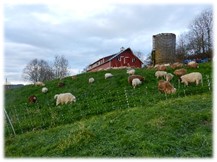 I value my veterinarian’s time and expertise. She works extremely hard, often taking appointments starting at 8 AM, and is still making phone calls on case notes at 8 PM! By law, in order for her to prescribe medications for my sheep, we need to maintain a Veterinary-Client-Patient Relationship (VCPR). I do sometimes bring sheep into her clinic for diagnosis or treatment. But I also make sure to pay for her time to visit my farm once a year, for a “well flock” visit, where she can view the whole flock and my operation.
I value my veterinarian’s time and expertise. She works extremely hard, often taking appointments starting at 8 AM, and is still making phone calls on case notes at 8 PM! By law, in order for her to prescribe medications for my sheep, we need to maintain a Veterinary-Client-Patient Relationship (VCPR). I do sometimes bring sheep into her clinic for diagnosis or treatment. But I also make sure to pay for her time to visit my farm once a year, for a “well flock” visit, where she can view the whole flock and my operation.
I like to schedule this at the tail end of lambing. During lambing, if I have an emergency or something I can’t deal with on my own, of course I’ll call her right away. But often I just have odd cases that aren’t urgent (or are too late!) that I want to discuss with her for “next time.” I make a list of those, and we review them during her visit. I may have her examine some cases in the barn at that time. My vet is very generous with teaching, so it’s helpful to hear her verbalize her thought process in differential diagnosis and choice of treatment. She has also shown me things like how to splint a broken leg, or perform a necropsy, which are now invaluable tools in my toolbox!
She also does exams on my herding and guardian dogs and catches them up on their inoculations. Of course, I can do this myself, but I want to drive revenue to her business for the simple things. This way I can feel comfortable calling to ask for advice other times of the year, knowing I’m a good paying client. Investing in a strong relationship has its rewards: I’m able to text her any time, and she has even walked me through emergencies while she was on vacation! This kind of support is priceless.
Additionally, ahead of her visit, I type up a list of protocols I plan to follow during the year. I list my vaccination and parasite management strategy. I show a pareto chart of my lamb losses from the last year, so we can discuss her recommendations for changes in practice which might reduce those losses. Then I list every prescription medication I wish to purchase from her, and the indications for when I think each is to be used. This saves her time from having to create something like this for me. Instead, she can just review it, and provide comments and guidance. This becomes the  basis for her being able to dispense full bottles of medication to me all year, because we have an agreed-upon plan, and she has seen my whole flock. She’ll also draw up small quantities of expensive drugs for me, in red top tubes, for things I don’t use as often. Having all the meds I need, on hand, for emergencies is also priceless, and an important factor for animal welfare.
basis for her being able to dispense full bottles of medication to me all year, because we have an agreed-upon plan, and she has seen my whole flock. She’ll also draw up small quantities of expensive drugs for me, in red top tubes, for things I don’t use as often. Having all the meds I need, on hand, for emergencies is also priceless, and an important factor for animal welfare.
A new law, the “Guidance for Industry #263,” will be going into effect in 2023. This will make over-the-counter (OTC) antibiotics like Penicillin and Tetracycline no longer available without a valid veterinarian prescription. The Veterinary Feed Directive (VFD) has already been in effect for a few years and applies to antibiotics in feed and water that used to be OTC and now require a VFD which is basically a veterinarian prescription for drugs in feed.
PSA! I think it’s important to mention that there is a mental health crisis in the veterinary profession. The average student loan debt for vets is $183K. The capital investment in modern diagnostic equipment, drug inventory, clinic space and farm call trucks is tremendous, often bringing their outlay to get started well over $1M. Farm vets especially work long hours, doing physically, mentally and emotionally demanding work. The pressure from social media reviews adds to their stress, making it no wonder that we have concerning suicide rates in this profession. Thus, I never complain about my vet’s prices or the late evening phone calls catching up on my case notes. I try to always be very mindful of making sure her time is compensated and efficiently used, and my appreciation for her value is known.
I know many have fears about the impact of increased cost, or lack of access to important medications, with the coming changes to the VFD in 2023. In the “Sheep Stuff Ewe Should Know” podcast, Ryan Mahoney of Emigh Livestock, discussed how the state of California had already implemented similar rules several years ago. Even though they are a fifth generation, several-thousand-head ranch, Ryan reports that they still found additional value in the deeper relationship they built with their veterinarian, driven by the change in regs. I encourage everyone to get their ducks in a row: make that appointment, and work with your vet now to establish and define the parameters of your VCPR, ahead of the change. You may find this is the impetus you need to up your game on the veterinary care front. And you may one day wonder how you ever managed without it.
By: Michelle Canfield, EAPK Member
![]()


